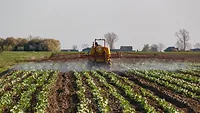USDA: "No Objection Letter" Not Required Cloth Sampling Procedure for STEC Testing
.webp?t=1661887788)
Credit: U.S. Department of Agriculture Food Safety and Inspection Service
The U.S. Department of Agriculture’s Food Safety and Inspection Service (USDA’s FSIS) has notified constituents that establishments wishing to adopt the cloth sampling method (i.e., manual sampling device or continuous sampling device) for Shiga Toxin-producing Escherichia coli (STEC) testing of raw beef products no longer require a “No Objection Letter” (NOL) from FSIS. Additionally, these establishments will not have to collect additional microbiological data when validating the cloth sampling method, if using the same parameters as their supporting documentation.
Establishments interested in implementing cloth sampling will still need to support the two elements of validation, such as scientific support and in-plant data, as they would for other routine changes. These elements are outlined on page four of the FSIS Hazards Analysis and Critical Control Points (HACCP) Systems Validation guideline.
For Element 1—Scientific Support, establishments could use the article in the Journal of Food Protection, which describes the cloth sampling method validated by USDA’s Agricultural Research Service (ARS). Alternatively, establishments could use FSIS Directive 10,010.1, Sampling Verification Activities for Shiga Toxin-Producing Escherichia coli (STEC) in Raw Beef Products, which outlines the cloth sampling method used by FSIS.
FSIS does not “approve” cloth manufacturers, and the adoption of the cloth sampling method is not an endorsement of a specific cloth manufacturer. Establishments must support that their sampling and testing methods can detect STEC, which may be present at a very low level. One way to support this is to ensure that the cloth is consistent with the one used in the supporting documentation for the sampling method used (size, material, etc.). Any departure from the process or critical operational parameters specified in the published support may require additional support or validation. For example, the cloth sampling method has not been validated by FSIS for use on frozen beef trim.
Establishments will also need to meet Element 2 of validation, which refers to in-plant data showing they can meet the specific parameters of the scientific support. Validation requirements of cloth sampling are the same for the validation of any other changes that affect the HACCP system.
Since FSIS has adopted the cloth sample collection methodology as robust, there is no longer an expectation for establishments to do side-by-side testing comparisons of the cloth and the N60 excision (or N60+ shaver) method. Instead, the establishment must document that they have incorporated and are achieving the parameters identified in their scientific support.
One key difference between the method cited in the Journal of Food Protection article and the FSIS method is the addition of neutralizing buffered peptone water by FSIS to facilitate microbiological recovery after shipment of the cloth to the FSIS laboratories. Establishments that ship to an off-site laboratory without using a transport buffer would need to support that decision (i.e., support that a lack of neutralizing buffer does not result in reduced recovery).
Questions regarding the use of cloth sampling by establishments can be submitted through askFSIS or by telephone at 1-800-233-3935. When submitting a question, complete the web form and select sampling as the inquiry type.
Looking for quick answers on food safety topics?
Try Ask FSM, our new smart AI search tool.
Ask FSM →




.webp?height=200&t=1661887788&width=200)



